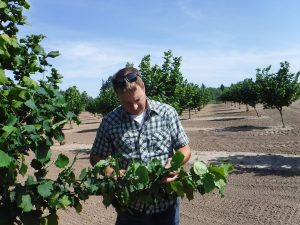
Jim Gerig checks the hazelnut trees on his farm in Salem, Oregon. An FSA microloan helped him plant 10 acres of trees that will be producing soon, following a five-year wait for the trees to mature.
By Michael Booth, Public Affairs Specialist
Jim Gerig grew up in a western Oregon farm family, but in the 1980s his father had to lease out the family land due to dwindling profit margins. Since then, he has kept a hand in the industry, working for farm supply and equipment companies. But the pull of farming kept calling to him.
“I just had a passion for it,” Gerig said. “I’ve worked in agriculture all my life, but had a passion to do it on my own.”
Some friends of his were growing a new, blight resistant variety of hazelnuts and after talking with them and doing more research, Jim and his father decided to plant five acres of trees on his father’s property. After managing that acreage and getting the hang of it, Jim decided to expand on his own with an additional 10 acres of trees on his aunt’s property.
Starting from scratch, though, proved to be an act of patience. Newly planted hazelnut trees take four to five years to begin producing, and that was a drawback with traditional lenders when Jim sought to obtain a loan for ground preparation and planting. That was when the lender suggested that Jim visit with USDA’s Farm Service Agency (FSA).
In 2013, after talking with Stuart Butsch, an FSA farm loan officer in Marion County, Oregon, it was determined that an FSA microloan made the most sense to get Jim started with planting. The terms of the loan kept payments low over an extended period while Gerig waited for the trees to start producing.
“It takes time for hazelnuts to pay off, but in the long-run it’s a sound investment,” Jim said. “You just need a minimal amount of equipment and you can harvest with just two people.”
Jim has since rented his father’s plot and is on his third year of harvesting hazelnuts. His additional 10 acres is nearly ready for its first year of production. He looks forward to the harvest, and to passing the operation on to his children one day.
Getting a start in farming takes research, time, and preparation before you dive in, Jim said. His advice to any new farmer is to learn all you can before you begin.
“You should always talk to people that have done it first,” he said. “Make sure you know what you’re getting into. It may sound simple, but it’s not. You have to have a passion for it and be willing to put in the work.”
Jim says keeping in touch with Stuart at the FSA office has also been helpful, even after the loan process.
“It’s been a great experience,” Jim said. “I’m not ready to expand yet, but we’ve been kicking around some ideas.”
Whether he decides to expand or not, Jim knows FSA will be there to help him continue in whatever direction his passion and patience take him.
To learn more about FSA microloans, visit www.fsa.usda.gov/microloans, or contact your local FSA county office. To find your nearest office, visit http://offices.usda.gov.





